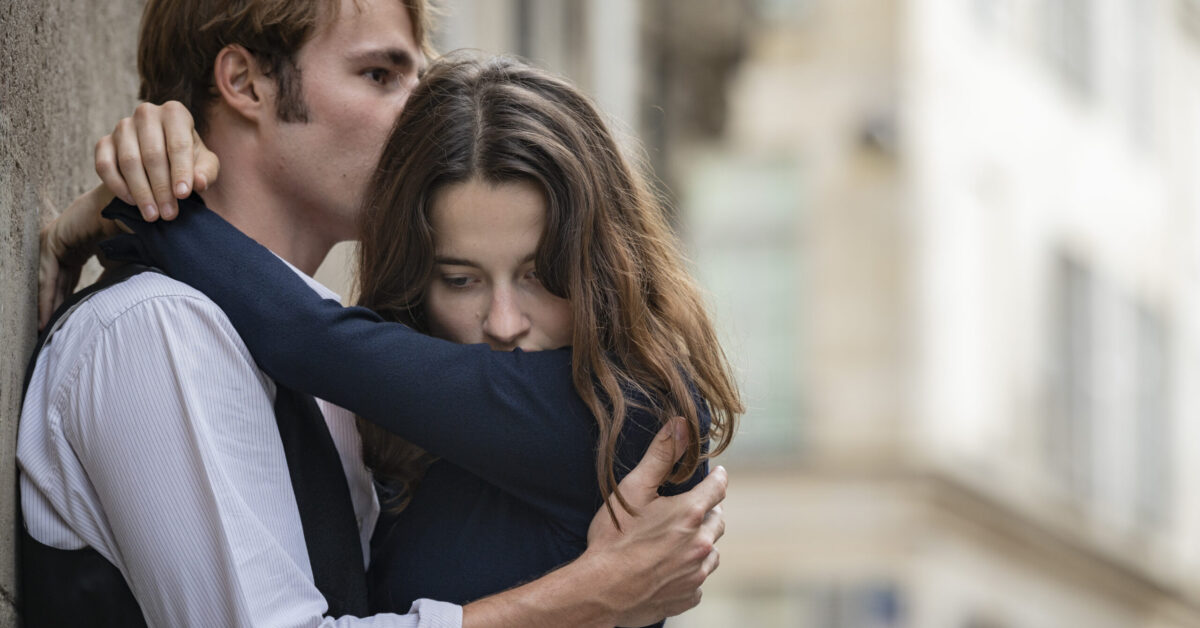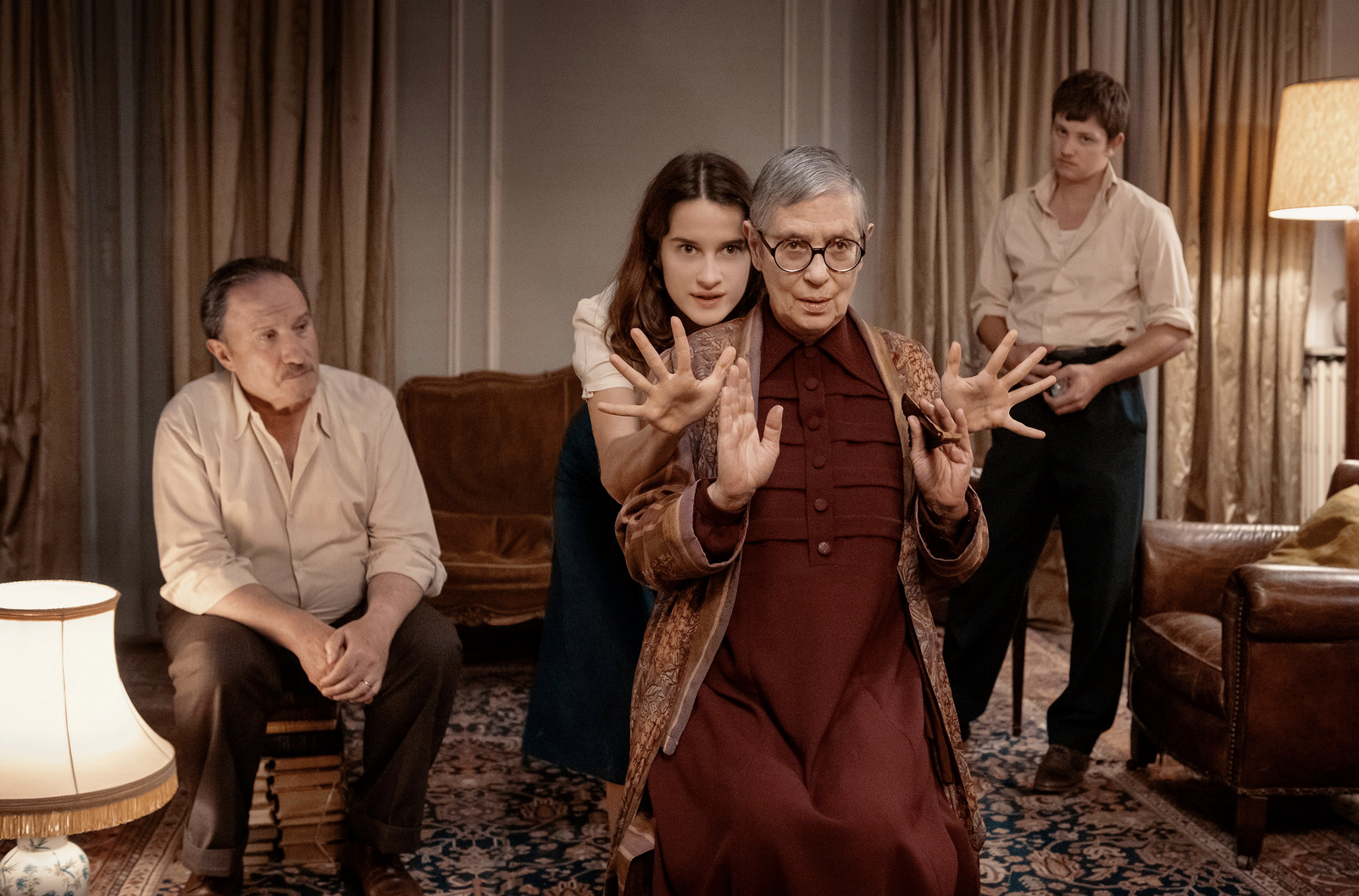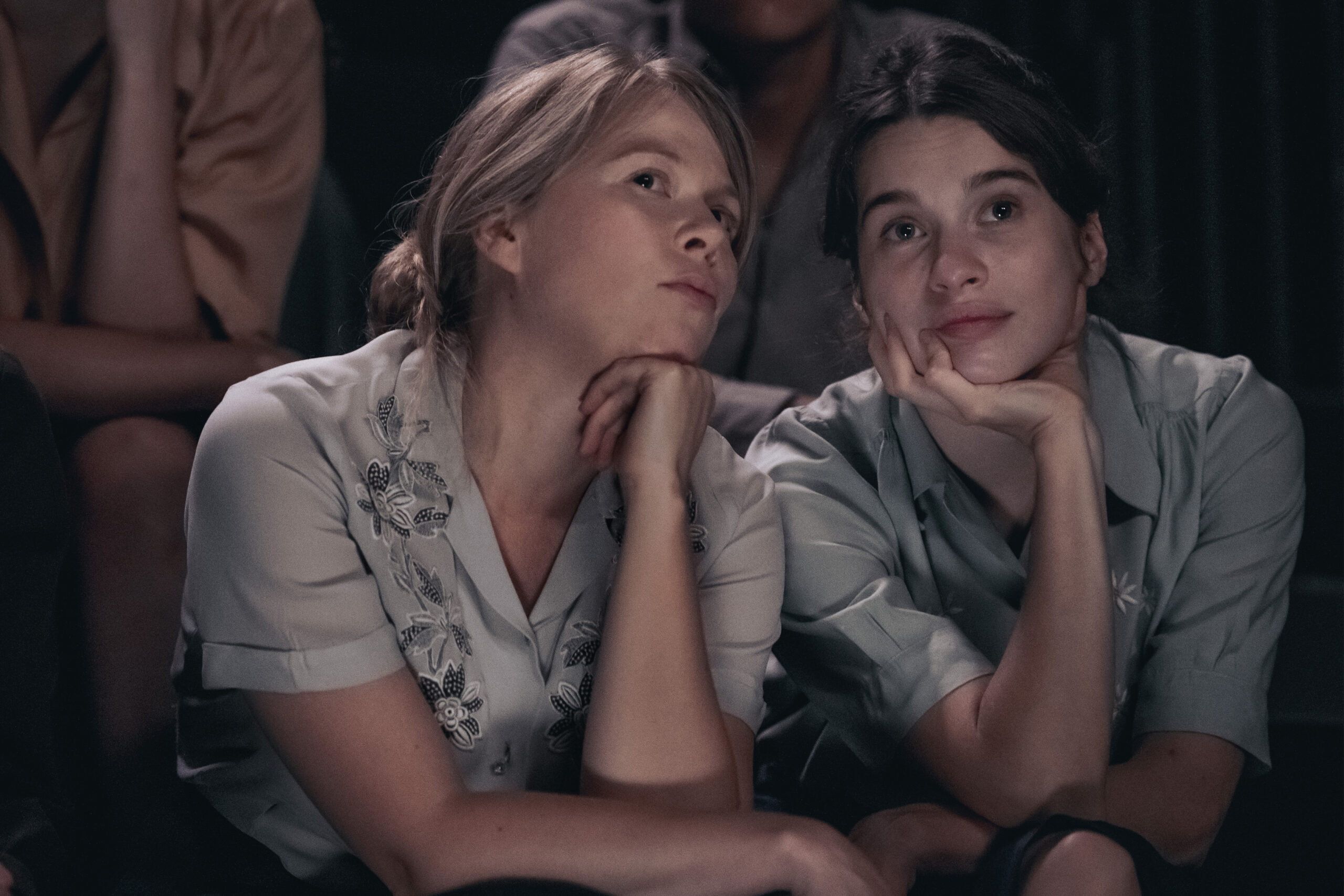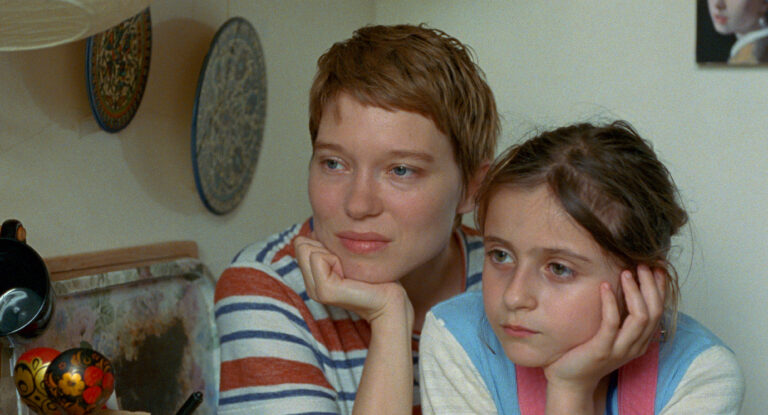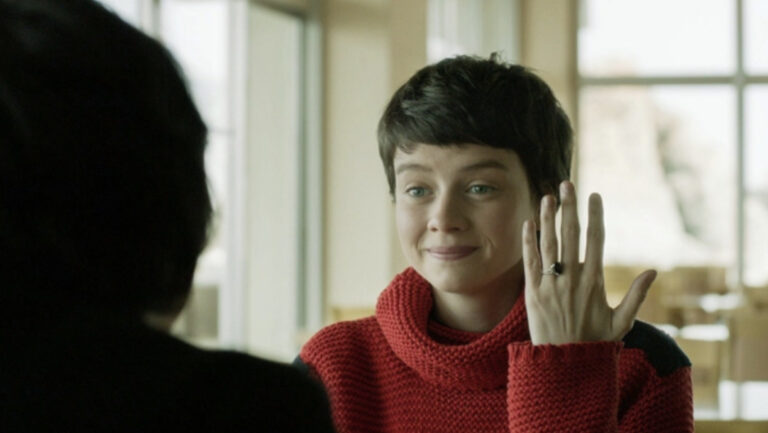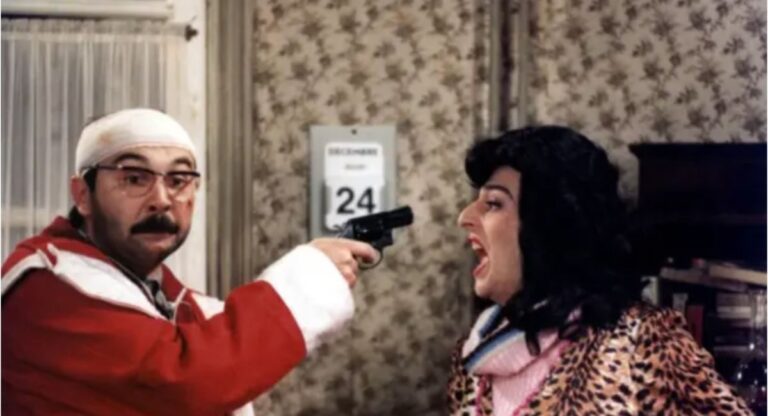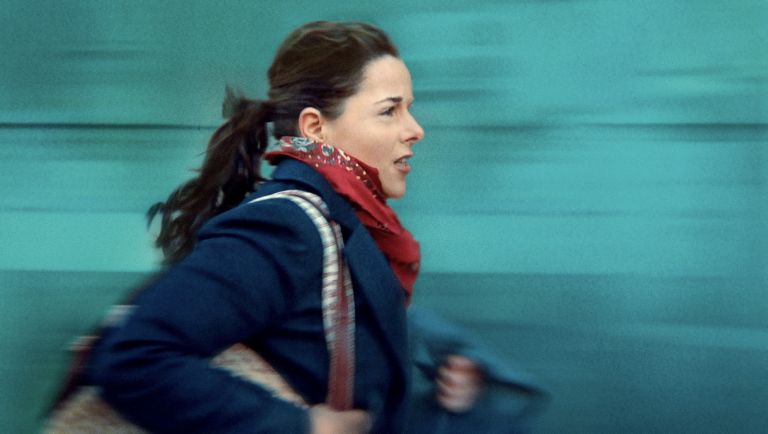It’s the summer of 1942, Paris. Irène (Rebecca Marder) is a passionate 16-year-old aspiring actress preparing to audition for the conservatoire. She flirts with one boy, discards him, falls madly for another. Life to Irène is full to the bursting. It makes her roam, dance, rebel, goof around, defy her protective father. She dreams about a bright, wide-open future boiling over with theater, love, laughter, sex, freedom. But it’s occupied France and she’s Jewish.
A Radiant Girl isn’t just another story about the German occupation of France. Not only is it told through the eyes of a teenage girl who’s overflowing with energy, optimism, and joy, but also the film stands out for some surprising choices on the part of writer/director Sandrine Kiberlain, best known as an actor in such films as Number One Fan, 9 Month Stretch, Mademoiselle Chambon, Alias Betty, and A Self-Made Hero. Despite the period during which it takes place, as a viewer we see no Germans troops or Nazi flags on the Champs-Élysées. The characters look contemporary. There are gestures to the period—a vintage dress, aging books on shelves—but visually it’s never made clear that this is 1942. Any hardship or concern on the part of Irène’s Jewish family is suggested only through bits of dialogue. Irène’s father (André Marcon) and grandmother (Françoise Widhoff), who lives with them, argue about stamping their identification papers with the word Juif or Juive. He is adamant they should. She threatens to jump out the window if he dares.
If the stamps were required, why is everyone so mad at Papa? If not, why does he insist? Questions like those arise while watching the film that could impede viewers from immersing themselves completely in the potentially riveting story of a vibrant, energetic, and, yes, radiant, girl moving toward a future she’s ravenous for, as the threat of the Germans hovers like storm clouds. The danger is barely acknowledged by Irène or anyone else in the film, except her father. Are they all in denial? Unaware of the risks? The film doesn’t clarify (although Irène does have fainting spells, which might mean something). When the family is forced to give up their bicycle, Irène’s gallant new boyfriend buys her a new one. One day a yellow star appears on her jacket. Annoying, but life goes on.
I spoke with writer/director Kiberlain and her star, Rebecca Marder of the Comédie Française, about this intriguing, if at times puzzling, film and why it’s so important for people to see it.
Sandrine, what was your first spark for the film?
Director, Sandrine Kiberlain: This is a period that’s been filmed many times, both well and poorly. It’s kind of an obsession for me, and I wanted to find an angle that was personal and unique. I came up with the idea of telling the story through the eyes of someone young and full of joy, which seemed to me to be the most tragic. I didn’t want the film to be a historic reconstruction. I wanted to show audiences how relevant this story is today. I wanted Irène to be a character for all time—past, present, and future—regardless of nationality or country. By making the film feel contemporary, I hope to reach people and show them that this type of injustice is still present. There are plenty of Irènes today, and there will be plenty of Irènes in the future.
Why were you obsessed with this period in particular?
Kiberlain: I want everyone to be obsessed with this period, because we still don’t understand how this could have happened and what enabled people to just go on living. It’s been an obsession for me since I was little. I was personally affected, being Jewish, of Jewish descent. We lived this. It’s unimaginable that we don’t talk about it anymore, because we still don’t have any answers and that’s partially my obsession, that this kind of injustice exists and it could happen again. It’s important to keep talking about it, so we don’t forget.
Part of what is unique is that you tell the story of the Occupation through the eyes of this vibrant young girl with a bright future ahead of her. She’s so carefree, hopeful, and full of life, it’s even more horrible to imagine that her life might be stopped short.
Actress, Rebecca Marder: Youth, hope, passion, love—youth especially—should never be cut off. It’s against nature and horrifying. Being a student, doing auditions, first love, achieving her dreams… This is what makes the story timeless. It’s the insolence of youth, too, that the world can fall apart and what’s most important is to meet your boyfriend and go to drama lessons. She’s aware of what’s going on, but her passion is more important than anything. The movie shows that youth is hope and hope is life, and that’s really what is moving for me. This film is about yesterday, so we know what is going to happen. We have 60 years of history to learn from, but it is also about the Irène of today and tomorrow. I feel very lucky to have the freedom to be an actress. In Ukraine and Iran, actresses cannot work. Irène is universal and timeless.
With the exception of Irene’s father, the family seems naïve about the potential fate of the French Jews. Is the film making a statement about the French being unaware, or not wanting to face that the worst could happen, or believing if they are good, upstanding citizens who follow the rules nothing bad will happen to them?
Kiberlain: I wanted to put myself in the place of multiple generations. There’s this young girl with all her spirit and optimism and her way of taking risks and following her heart. There’s her father, whom I imagined as the protector, who follows the rules and doesn’t want to take risks. You have her grandmother who’s liberated like a young girl and resistant at heart. There are other people, secondary characters, her best friend who doesn’t see any difference between Irène and the others, her brother who is discovering the world and who flirts with the enemy and maybe even learns something about collaboration. There’s also the young man Irène meets who’s innocent and doesn’t care that she’s from another culture or religion, and their neighbor Josiane who just wants to explore Jewish culture. With the secondary characters around Irène, I wanted to show all that was lived in everyday life at this crucial time before the real drama began. I felt it was important that they be French, that this take place in France, because of the antisemitism in France at the time.
Irene is so full of joy, she bounces and sparkles and moves almost non-stop. It’s like a dance. The way she moves is another way of expressing all her youthful energy. Can you talk about Irène as a character who’s so full of youthful joy and energy?
Marder: Sandrine wanted to always keep the camera moving and following this girl who’s really lively. Sandrine is really precise, and she knows what she wants. Every detail was choreographed, from the dialogue to the flower embroidered on my shirt. There was no room for improvisation. It’s part of both Sandrine and me to be so full of life and always in motion. We share with Irène that energy and force of life.
Kiberlain: I wanted to create a strong contrast between her liveliness and joy and what we, the viewer, fear for her. The more she moves, the more vivacious and joyful she is, the more we fear for her, because we know what could happen to her.
Marder: The directions between Sandrine and me were not spoken. We didn’t have to exchange too many words. It was really physical. I felt carried by her and lifted up by her. During the shoot, she’d stand really close to the scene, one meter away, so I could hear her breathe or laugh or cry. It was subtle, but there was a thread between us, so that added to how physical it feels when you watch the movie.
The audience doesn’t realize we’re in occupied France until the conversation about getting the ID cards stamped. You provide a few signposts for the viewer—the stamps, their radio and bicycle being seized, the yellow star—but it’s subtle. You create a very gradually encroaching feeling of dread. How did you conceive that part of the story?
Kiberlain: I thought it was sufficient to refer to the actual time period maybe three or four times. Without being too explicit, the spectator understands what’s happening. The viewer knows the period, so we only have to say we’re going to get the word Juif stamped in our identification papers or see the yellow star appear on her jacket. We see the jacket she wears every day, then hop! there’s the star. Just these bits of information throughout the film are sufficient for the spectator to understand where we are. I didn’t want to spell everything out. Sometimes we perceive danger from the absence of details: the deserted streets, the silence in the streets. We project or imagine the rest. We understand the images of the time period from one or two details—a flag, a boot—because we know them by heart. I felt it was important not to cheat on how this period was felt by the people who lived through it. I had the opportunity to speak with some people who lived through is, and they said it was important to emphasize the “before.” You have an almost excessive sense of joie de vivre. When there’s a sense of menace that hasn’t entirely presented itself yet, we tend to live fully. When the fear becomes real, the other shoe drops, so it’s important to show what happens before.
I’ve always loved this quote by Agnès Varda, one of my favorite quotes about cinema: “I don’t want to show things, but to give people the desire to see.”
Who are your artistic influences?
Kiberlain: There are so many. We were just speaking of Agnès Varda, certainly. I would have loved to work with her. I think if I’d worked with him, I would have fallen in love with Francois Truffaut! I would have loved to work with Maurice Pialat, with Sydney Pollack. I’d love to work with Wong Kar Wai, Nanni Moretti, with Scorsese, Woody Allen, so many filmmakers, Greta Gerwig, Hitchcock…There are so many!
Marder: I feel very inspired by the Italian neo-realist cinema of the 50s. One of my goddesses is Anna Magnani, all the Rossellini movies. I also love Douglas Sirk, Charlie Chaplin, Truffaut. Actresses I admire are Gena Rowlands and Sandrine Kiberlain! Today, I love Thomas Vintenberg, the Safdie brothers, Lucas Dhont…
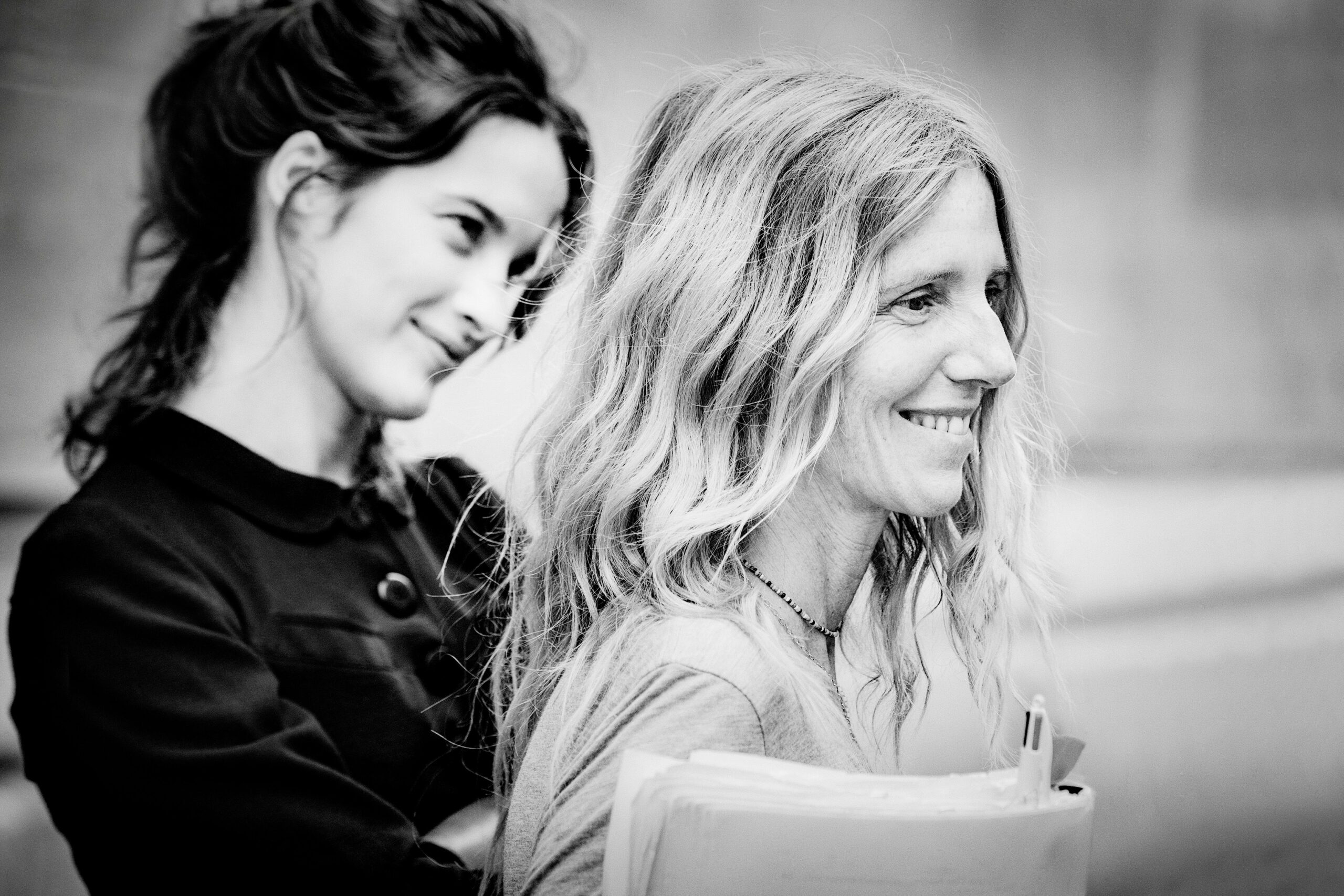
What’s next for both of you? And Sandrine, in a perfect world, how would you balance acting and directing?
Kiberlain: I don’t have the pressure of most directors who, upon finishing one project, must immediately be on the lookout for the next. I don’t think I could live that way. Fortunately, I’m an actress. That was my first vocation, and in an ideal world I’d like to do both. I hope to continue to work with directors I admire. That’s still an important part of my life, but I must say that directing this film was one of the best experiences of my life, and I hope to do another soon. I have some ideas, but they are still percolating. I’d like to make another soon.
Marder: I have two movies coming out next month in France, one by Francois Ozon, The Crime is Mine, and one by Sylvain Desclous called Grand Expectations. It’s not Dickens, it’s a thriller that I really loved doing. They’re both coming out in March in France. Then I’m going back to the theater in April, doing a play about tango with an Argentinian director, and I hope in the future to collaborate again with Sandrine, because for me too it was one of the most beautiful, human, and artistic experiences I’ve ever had.
A Radiant Girl opens exclusively in theaters in New York on Friday, February 17, followed by a national release.
Andrea Meyer has written creative treatments for commercial directors, a sex & the movies column for IFC, and a horror screenplay for MGM. Her first novel, Room for Love (St. Martin’s Press) is a romantic comedy based on an article she wrote for the New York Post, for which she pretended to look for a roommate as a ploy to meet men. A long-time film and entertainment journalist and former indieWIRE editor, Andrea has interviewed more actors and directors than she can remember. Her articles and essays have appeared in such publications as Elle, Glamour, Variety, Time Out NY, and the Boston Globe.

